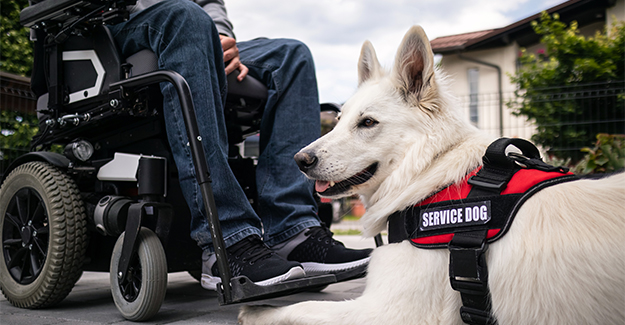International Assistance Dog Week honors heroic dogs and highlights their unique needs

This year’s International Assistance Dog Week (IADW) runs from August 7-13, 2022. According to the IADW website, this week was created to recognize and honor all the “devoted, hardworking assistance dogs helping individuals mitigate their disability related limitations.” As part of this, this week shines a spotlight on assistance dogs, puppy raisers and trainers, and the amazing work done by all of these groups.
Assistance dogs are part of a larger group included in the AAHA 2021 Working, Assistance, and Therapy Dog Guidelines developed to help veterinary practitioners better meet the unique needs of these hardworking dogs. The guidelines were authored by a group of veterinary professionals led by Cynthia Otto, DVM, PhD, who is also the director of the Working Dog Center at the University of Pennsylvania School of Veterinary Medicine. According to the guidelines, “assistance animals do work, perform tasks, provide assistance, or provide psychological support for a person with a physical or mental impairment that substantially limits at least one major life activity or bodily function.”
The guidelines define assistance dogs as a broad category that includes both service dogs and emotional support dogs. Service dogs are not considered to be pets, but rather highly trained dogs who have been designated to assist their handler with one or more specialized tasks based on the handler’s disability. They have usually been carefully bred and deliberately raised to ensure good health and an appropriate temperament prior to being trained for tasks such as assisting the blind, aiding in mobility, or alerting to allergies, seizures or low blood sugar in their handler.
Emotional support dogs are considered to be pets and do not have the specialty training and breeding associated with service dogs, nor do they have the same rights to access to public places and transportation afforded to service dogs. Nonetheless, they can provide an invaluable benefit to their owners in terms of providing companionship and coping assistance with a variety of challenges. These can include depression, anxiety, panic attacks, and obsessive-compulsive disorder.
For both categories of assistance dogs, the guidelines spell out recommended healthcare considerations and areas of focus. These include “standard canine preventive care based on lifestyle” (vaccines, parasite prevention and lab work) and in some cases assistance with frequent health certificates for travel. Veterinary personnel should be aware that assistance dogs, particularly service dogs, are considered to be “working” when they are wearing their harness or vest and therefore should not be examined or treated while they are wearing it. The recommendations include allowing the handler to be present for care whenever possible and learning the special commands the dog has been taught.
Assistance dogs can be at higher risk of developing separation anxiety, toxicity from exposure to a handler’s medications, arthritis, injuries, fatigue, and burnout. Veterinary staff should learn to recognize conditions that may interfere with an assistance dog’s ability to perform their job and that may warrant retirement. Handlers with disabilities may also have difficulty administering medication and other treatments, and this must be accounted for in any treatment plan.
When asked what she would most like the veterinary profession to know most about assistance dogs, Otto stressed understanding the differences between service, emotional support, and therapy dogs and how these differences impact the way we think about their veterinary care. If a service dog needs a dental procedure, for example, they may not be able to perform their normal duties for 24 hours or more as they recover from anesthesia. This must be carefully coordinated when planning a procedure.
Additionally, Otto stresses the need to be “brutally honest” with dog handlers about their dog’s body condition. She describes veterinary professionals as often being “overly generous” with our body condition scoring. This can do a disservice to assistance dogs and their handlers, as obesity can shorten lifespan and predispose dogs to disease and pain. Instead, she recommends giving assistance dog handlers clear guidelines and strategies to help keep their dogs at a healthy weight.
There are multiple resources available for use by veterinary professionals looking for more guidance in their treatment of assistance dogs. These include the 2021 AAHA Working, Assistance and Therapy Dog Guidelines and AVMA’s page on Service, emotional support, and therapy animals. The International Assistance Dog Week webpage also has a listing of events going on throughout the week, and the Assistance Dogs International webpage has information on laws, standards, definitions and an opportunity to make a donation to support this important work.
Photo credit: © 24K-Production/iStock/Getty Images Plus via Getty Images



